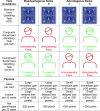Age-group differences in trust-related decision-making and learning
- PMID: 38167997
- PMCID: PMC10762071
- DOI: 10.1038/s41598-023-50500-x
Age-group differences in trust-related decision-making and learning
Erratum in
-
Author Correction: Age-group differences in trust-related decision-making and learning.Sci Rep. 2024 Mar 1;14(1):5132. doi: 10.1038/s41598-024-55891-z. Sci Rep. 2024. PMID: 38429420 Free PMC article. No abstract available.
Abstract
Facial impressions contribute to evaluations of trustworthiness. Older adults are especially vulnerable to trust violations, incurring risks for deception and exploitation. Using the newly developed social Iowa Gambling Task (S-IGT), we examined age-group differences in the impact of facial trustworthiness on decision-making and learning. In the congruent condition (CS-IGT), advantageous decks were paired with trustworthy faces and disadvantageous decks with untrustworthy faces. In the incongruent condition (IS-IGT), this pairing was reversed. Younger (n = 143) and older (n = 129) participants completed either the standard Iowa Gambling Task (IGT), CS-IGT, or IS-IGT. Both age groups preferred trustworthy faces in their initial choices. Older adults performed worse than younger adults across all tasks over time. Further, compared to younger adults, older adults performed worse on the IS-IGT, suggesting that incongruent facial cues interfered with older adults' performance, which aligns with reduced sensitivity to negative social reputations in aging. Multilevel modeling also indicated that age-group differences were most pronounced across all tasks in the last 40 trials. Together these findings suggest that differences between younger and older adults in experience-dependent decision-making are magnified in social contexts that involve a "wolf in sheep's clothing," which may reflect age-related difficulties in integrating incongruent information.
© 2024. The Author(s).
Conflict of interest statement
The authors declare no competing interests.
Figures


Similar articles
-
Functional neuroimaging of the Iowa Gambling Task in older adults.Neuropsychology. 2014 Nov;28(6):870-80. doi: 10.1037/neu0000120. Epub 2014 Jul 28. Neuropsychology. 2014. PMID: 25068669
-
Underlying decision making processes on Iowa Gambling Task.Asian J Psychiatr. 2019 Jan;39:63-69. doi: 10.1016/j.ajp.2018.12.006. Epub 2018 Dec 21. Asian J Psychiatr. 2019. PMID: 30586668
-
Integrating frequency and magnitude information in decision-making in schizophrenia: An account of patient performance on the Iowa Gambling Task.J Psychiatr Res. 2015 Jul-Aug;66-67:16-23. doi: 10.1016/j.jpsychires.2015.04.007. Epub 2015 Apr 28. J Psychiatr Res. 2015. PMID: 25959618 Free PMC article.
-
A critical review of sex differences in decision-making tasks: focus on the Iowa Gambling Task.Behav Brain Res. 2013 Feb 1;238:95-108. doi: 10.1016/j.bbr.2012.10.002. Epub 2012 Oct 16. Behav Brain Res. 2013. PMID: 23078950 Review.
-
[Decision-making and schizophrenia].Encephale. 2011 Dec;37 Suppl 2:S110-6. doi: 10.1016/S0013-7006(11)70036-7. Encephale. 2011. PMID: 22212839 Review. French.
Cited by
-
Perceptual judgments are resistant to the advisor's perceived level of trustworthiness: A deep fake approach.PLoS One. 2025 Apr 16;20(4):e0319039. doi: 10.1371/journal.pone.0319039. eCollection 2025. PLoS One. 2025. PMID: 40238842 Free PMC article.
-
Lying to an older adult in a sharing situation: differences between young and mid-life adults.Front Psychol. 2025 Jun 18;16:1541248. doi: 10.3389/fpsyg.2025.1541248. eCollection 2025. Front Psychol. 2025. PMID: 40606893 Free PMC article.
-
Editorial: The cognitive ageing collection.Sci Rep. 2024 May 13;14(1):10869. doi: 10.1038/s41598-024-60763-7. Sci Rep. 2024. PMID: 38740780 Free PMC article.
References
-
- Simpson JA. Psychological foundations of trust. Curr. Dir. Psychol. Sci. 2007;16(5):264–268. doi: 10.1111/j.1467-8721.2007.00517.x. - DOI
MeSH terms
Grants and funding
LinkOut - more resources
Full Text Sources
Medical

